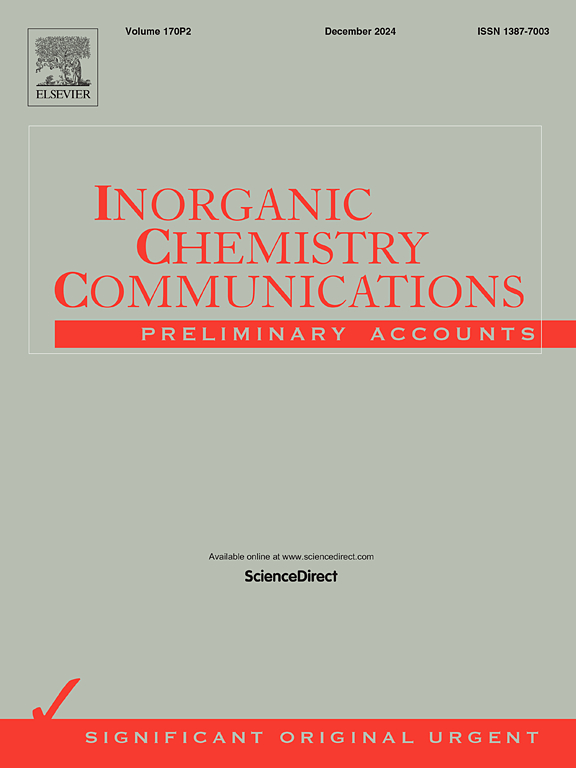Structural and theoretical investigations of 3D Ni-formate framework: Exploration as selective fluoroprobe for detection of industrial solvents
IF 4.4
3区 化学
Q1 CHEMISTRY, INORGANIC & NUCLEAR
引用次数: 0
Abstract
This research reported the solvothermal synthesis of a nickel-based metal formate framework (MFF) templated by protonated amines which served as a sensing platform, for the detection of industrial solvents, namely acetone and ethyl methyl ketone, with exceptional specificity and recyclability for up to seven cycles. The synthesised Ni-formate framework was characterised using single crystal X-ray diffraction (SCXRD), Fourier-transform infrared spectroscopy (FT-IR), field emission scanning electron microscopy with energy-dispersive X-ray spectroscopy (FESEM-EDS), and thermogravimetric analysis (TGA). The DFT analyses offer a comprehensive estimation of charge density distribution and the electron localisation function (ELF) of the Ni-formate framework. The exceptional emissive properties of the Ni-formate framework, examined in various chemical solvents, were employed to create MFF-based ’turn-off’ luminescence sensing for organic molecules containing aldehyde and ketone functional groups. The findings demonstrated that our proposed probe provide exceptional recognition capability for acetone and ethyl methyl ketone among the various carbonyl compounds probed. The Ni-formate framework with both commercial solvents demonstrates a strong linear correlation between the relative fluorescence intensity (Io/I) and solvent concentration within the range of 0–100 μM. The detection limits for spectrofluorometric analysis of acetone and EMK were determined to be 3.3 µM and 3.522 µM, respectively. The Stern–Volmer constant was calculated as 1.01 × 106 M−1 for acetone and 1.02 × 106 M−1 for EMK, indicating substantial interaction among Ni-MFF and the solvents. The Ni-formate framework exhibited fluorescence quenching approximately with in one minute of exposure to an aqueous solution containing acetone and EMK. The study demonstrates the potential of nickel-based metal formate framework sensor for rapidly identifying industrial solvents with significant sensitivity, good selectivity, and recyclability without a decline in fluorescence efficiency.

三维甲酸镍骨架的结构和理论研究:作为工业溶剂检测的选择性氟探针的探索
本研究报道了以质子化胺为模板的镍基金属甲酸酯框架(MFF)的溶剂热合成,该框架作为检测工业溶剂(即丙酮和乙基甲基酮)的传感平台,具有优异的特异性和可循环性,可达7个循环。采用单晶x射线衍射(SCXRD)、傅里叶变换红外光谱(FT-IR)、场发射扫描电子显微镜(FESEM-EDS)和热重分析(TGA)对合成的甲酸镍骨架进行了表征。DFT分析提供了对ni -甲酸酯框架的电荷密度分布和电子定域函数(ELF)的综合估计。在各种化学溶剂中测试了甲酸镍框架的特殊发射特性,并利用该特性为含有醛和酮官能团的有机分子创建了基于mff的“关闭”发光传感。结果表明,我们提出的探针在探测的各种羰基化合物中对丙酮和乙基甲基酮具有特殊的识别能力。在0 ~ 100 μM范围内,两种商业溶剂的甲酸镍骨架的相对荧光强度(Io/I)与溶剂浓度呈较强的线性相关。丙酮和EMK的荧光光谱分析检出限分别为3.3µM和3.522µM。计算得到丙酮的Stern-Volmer常数为1.01 × 106 M−1,EMK的Stern-Volmer常数为1.02 × 106 M−1,表明Ni-MFF与溶剂之间存在明显的相互作用。在含有丙酮和EMK的水溶液中,大约在一分钟内,甲酸镍骨架的荧光猝灭。该研究表明,镍基金属甲酸酯框架传感器具有快速识别工业溶剂的潜力,具有显著的灵敏度,良好的选择性和可回收性,而不会降低荧光效率。
本文章由计算机程序翻译,如有差异,请以英文原文为准。
求助全文
约1分钟内获得全文
求助全文
来源期刊

Inorganic Chemistry Communications
化学-无机化学与核化学
CiteScore
5.50
自引率
7.90%
发文量
1013
审稿时长
53 days
期刊介绍:
Launched in January 1998, Inorganic Chemistry Communications is an international journal dedicated to the rapid publication of short communications in the major areas of inorganic, organometallic and supramolecular chemistry. Topics include synthetic and reaction chemistry, kinetics and mechanisms of reactions, bioinorganic chemistry, photochemistry and the use of metal and organometallic compounds in stoichiometric and catalytic synthesis or organic compounds.
 求助内容:
求助内容: 应助结果提醒方式:
应助结果提醒方式:


